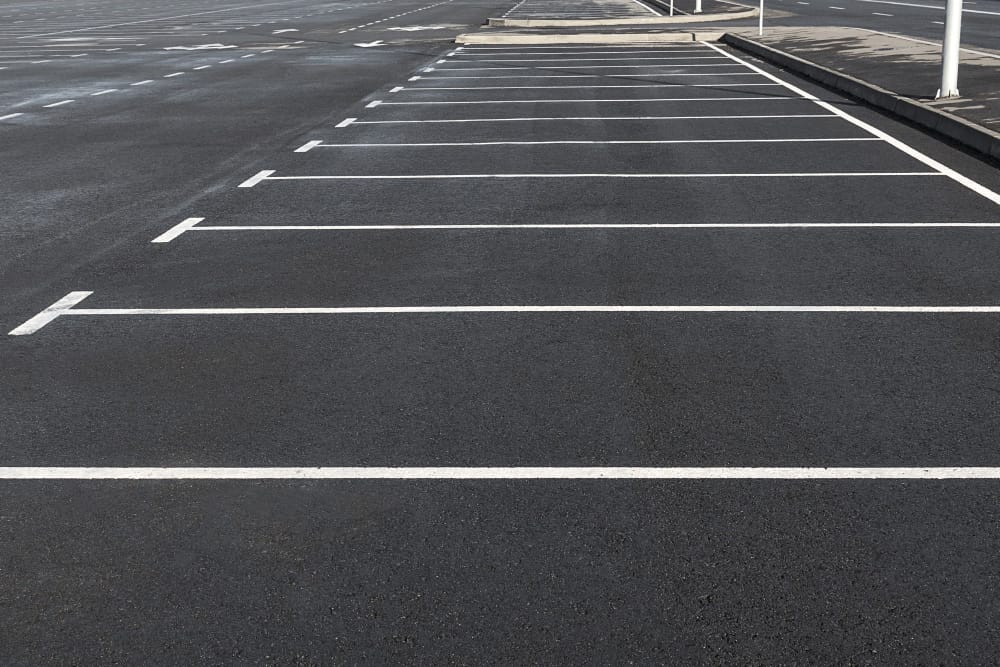Complete Guide to Chip Sealing: Looking to revamp your asphalt parking lot with an effective and budget-friendly solution? In this Complete Guide to Chip Sealing Your Asphalt Parking Lot, we’ll take a deep dive into chip sealing, a game-changer for parking lots that merges the resilience of asphalt with the protective barrier of seal coating.

Looking to revamp your asphalt parking lot with an effective and budget-friendly solution? In this comprehensive guide, we’ll take a deep dive into chip sealing, a game-changer for parking lots that merges the resilience of asphalt with the protective barrier of seal coating. Companies and property owners, especially in the Bandera, TX area, will find this information particularly invaluable.
Understanding Chip Sealing with Complete Guide to Chip Sealing
Chip sealing, often referred to as “tar and chip” or “seal chip,” is a process that combines liquid asphalt and fine gravel, or “chips,” to restore and protect roadways. It’s a fantastic alternative for areas where hot mix asphalt might not be practical or cost-effective.
The Process of Chip Sealing
Chip sealing begins with a coat of hot liquid asphalt on the pavement, followed by a layer of small, crushed rock. This process continues, with additional layers of asphalt and stone applied, with each layer complementing the other to form a strong, jointless surface.
Benefits of Chip Sealing
Enhanced Durability: Chip sealing effectively waterproofs the paved surface, reducing the chance of water seeping into the base and deteriorating the pavement.
Cost-Efficiency: It costs less than other resurfacing techniques, which makes it an attractive option for large parking areas.
Quick Application: Chip sealing can often be completed in one day, allowing for speedy restoration and minimal disruption.
When to Chip Seal Your Parking Lot
Knowing the right time to pursue chip sealing for your parking lot is crucial. Winter months and rainy seasons can be the most damaging, and fall or spring are often the best times for maintenance actions such as chip sealing.
Signs Your Parking Lot Needs Chip Sealing
- Cracking on the surface
- Fading and weathering of the current seal
- Water pooling in troughs or low spots
Choosing the Right Materials with Complete Guide to Chip Sealing
Selecting the right materials is paramount to the success of your chip sealing project.
Asphalt Mix Types
Different climate conditions might necessitate different asphalt mixtures. Your choice depends on factors such as seasonal temperature variations and expected traffic loads.
Chip Selection
The size of the chips affects the overall appearance and texture of the sealed surface. It also plays a role in the durability and skid resistance.
Working with the Professional Team
Hiring a professional team like C. Brooks Paving can ensure your chip sealing is done right the first time.
Understanding the Quote
Don’t be afraid to ask for a breakdown of the costs before agreeing to any services. The quotation should cover materials, labor, and any additional requirements specific to your project.
Project Timelines
Get a detailed project plan with start and end dates. Weather can impact these, so make sure there’s a contingency plan.
The Application Process
Understanding what to expect during chip sealing is critical for effective project management.
Surface Preparation
Before chip sealing, the surface must be cleaned and any necessary repairs made. This includes addressing cracks and ensuring the base is stable.
Chip Spreader Technique
Professionals use a chip spreader to apply the aggregate evenly across the hot liquid asphalt layer. The spreader must be calibrated correctly for an optimal application.
Rolling for Compaction
After the chips are spread, heavy rollers compact the surface to embed the chips into the asphalt. The goal is to create a smooth, durable surface that prevents loose aggregate.
Caring for Your Sealed Parking Lot
A freshly chip-sealed parking lot requires some post-care to ensure its longevity.
Avoiding Early Traffic
Newly-sealed lots need time for the surface to set. Keep traffic to a minimum for the specified time.
Regular Maintenance
Having a maintenance plan in place will keep your parking lot looking great and functioning well for years to come.
Environmental Considerations
Chip sealing can impact the environment, so it’s important to handle materials responsibly.
Disposal of Used Materials
Ensure that the disposal of unused materials and waste complies with all environmental regulations.
Eco-Friendly Options
Ask about eco-friendly choices for chip seal materials. Some companies offer options that reduce the carbon footprint of your project.
Maximizing the Investment
Your chip sealing investment can last a long time with proper care and maintenance.
Longevity
A well-maintained chip sealed parking lot can last from five to seven years or longer, depending on usage and climate conditions.
Regular Inspections
Frequent inspections can catch minor issues before they become major, saving you money in the long run.
Evaluating the Return on Investment
Investing in chip sealing for your parking lot is a significant decision.
Assessing the Value Added
A freshly sealed parking lot not only looks better but retains the value of your property by maintaining a well-kept appearance.
ROI Calculations
Work with your professional team to calculate the expected return on your chip sealing investment over time.
In Summary: Complete Guide to Chip Sealing
Chip sealing is a cost-effective way to maintain the integrity of your parking lot pavement. By understanding the process, working closely with professional paving personnel, and committing to ongoing maintenance, you can enjoy the benefits of a beautifully restored lot for years to come.
If you need professional help with chip seal in Bandera, TX, and you need professional assistance, get in touch with C. Brooks Paving. Contact them today to schedule an appointment or to learn more about their chip sealing services tailored to your needs. With the right approach, your chip sealed parking lot will be a testament to the power of proactive maintenance.
Follow C Brooks Paving on Facebook





